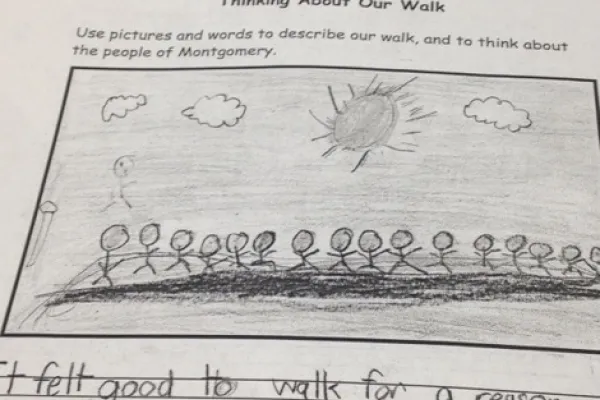Peer Learning: Campus School Teachers Host Roundtables for Fellow K-12 Educators
Smith & Northampton

Published March 5, 2015
A group of elementary school teachers gathered in a meeting room at the Campus Center one day last month to work on an unusual assignment: What did a student essay about the Montgomery bus boycott of the 1950s reveal about the child’s learning?
Led by Lara Ramsey, a teacher at the Smith College Campus School, the educators shared initial observations without knowing the student’s grade level or background information about the assignment.
“We’ll read the text and raise questions without judging,” Ramsey explained to participants. “Then we’ll take a break and the teacher who made the assignment will respond.”
The exercise, known as a Collaborative Assessment Conference—which Ramsey encountered at a training at the University of Vermont’s Prospect Archive—was designed to help teachers “give close attention to student work,” she said. “The more you are attuned to the particulars, the more you learn about a child.”
The session was one of the regular monthly teacher roundtables that Ramsey and colleagues from the Campus School host for fellow K-12 educators in the region. The gatherings, which began as part of Ramsey’s dissertation research a decade ago, offer teachers a chance to learn from each other and share student work in a supportive setting.
Amanda Hernandez ’14 said she has been coming to the roundtables for nearly a year.
“I love it!” said Hernandez, who is an assistant pre-school teacher at the Clarke School for Hearing and Speech. “It’s refreshing to be around people in the education field talking about things that come up in the classroom.”
At last month’s session, teachers reviewed an essay a student wrote after taking a mile-long walk with classmates to echo the experience of participants in a civil rights-era bus boycott in Montgomery, Ala.
“It felt good to walk for a reason,” the essay began. A few lines later, the student reflected that if he met someone from Montgomery, he would ask “what it felt like to boycott the buses for 381 days.”
Participants shared observations about the student’s use of punctuation and the links between the drawing and the text. Teachers also wondered about erasure marks in the essay and whether the student had worked from a prompt or had written spontaneously about the walk.
Hernandez pointed out that the student’s thoughts moved between the bus boycott of the past and his own recent experience of walking with his classmates.
“I notice that time is important to this author,” she said.
Mary Bates, who teaches first grade at Jackson Street School in Northampton, picked up on that theme.
“It seems this child almost felt like they were transported back in time,” Bates said.
During the latter part of the roundtable, Campus School teacher Roberta Murphy—who has been part of the roundtables from the start—revealed that the essay was written by a student in her second grade class—a shy boy who she said is becoming a talented writer.
Murphy said the essay was done in class without revisions, and that students were asked to think about what they would do if they had a chance to ask questions of people who’d been part of the Montgomery bus boycott.
After learning more about the assignment, roundtable members began sharing ideas for other ways to spark student interest in history—and in writing.
“What if you did the class walk twice, once at the beginning and once at the end” of the unit on Montgomery, suggested Katie Butler ’12, who teaches second grade at Jackson Street School. That way, the teacher could track how students’ perceptions changed as they learned more about the civil rights movement, she said.
Others proposed that students could read their finished essays to each other as a way to spark further discussion.
Murphy said she was impressed by how perceptive fellow teachers were about her student’s abilities and challenges.
“It struck me that you noticed the carefulness of this student’s work,” she told the group. “He’s not someone who is at ease with making mistakes, and he sometimes gets tangled when he speaks. Writing is becoming his way of getting out what he has to express.”
Campus School teacher Janice Szymaszek ’78—another founding member of the roundtables—said giving teachers a deeper understanding of their students is the underlying goal of the gatherings.
“When Lara’s research was completed, we told her we wanted to keep meeting because of how profound the lessons were for us in our classrooms,” Szymaszek said. “This professional community she created has continued to advance our understandings, support our growth and inspire new possibilities.”
The next roundtable is scheduled for Saturday, March 7, from 9:30 to 11:30 a.m. For details, contact Ramsey at lramsey@smith.edu.